|
The Spirit and Style of MeihuazhuangCore Training MethodsThe JiaziA basic training routine known as the Jiazi serves as the foundation upon which other martial skills are built. The structure of the Jiazi is quite peculiar in that it is not composed of “fighting postures/stances” but of 5 static stances (zhuangbu) and moving steps (xingbu) for which provide foundational skills to the practitioner. The static stances (zhuangbu) are composed of 5 stances — Da, Shun, Ao, Xiao, Bai — which are based on the theory of mutual-supplement and mutual-restraint among the Five Elements in traditional Chinese thought. Each stance is held motionless for 3—5 breaths to develop the qi and strength. Through the cycle of relaxed, expanded stances, the muscles and tendons are stretched and strengthened. Misalignments of the limbs in relation to the body is corrected as tension is gently and gradually released from the major joints of the body. The joints “open”, become stable, strong and flexible and the limbs become coordinated with the body. The moving steps (xingbu), composed of Baifa (swinging method), Chefa (retreating method) and Zhafa (stabbing method), are the main training method to develop fast, rapid and light footwork enabling the practitioner to move in all directions effortlessly. The moving steps improve the coordination of the body and at the same time, develop attack, ambush, outflanking and retreating techniques. The static stances and moving steps are linked together to form the basic structure of the Jiazi. The basic pattern of the Jiazi contains eight directions, arranged according to the four cardinal directions and the intermediary diagonal directions. This pattern is known as the Simen or, literally, the “Four Doors”. The five stances are performed in each of the directions (also referred to as “corners”) and the overall pattern created resembles a plum flower in full bloom. These “corners” are connected by the moving steps which act like the stem and branches of the plum blossom. The most characteristic feature of the Jiazi, however, is the dynamic alteration between static stances and moving steps, a training method which coordinates the mind (shen — intention and thought) with breathing. The balanced left-right symetrical training methods are an exercise for the entire body. The Jiazi serves to train the collection and flow of qi, bring about correct postural alignment and body relaxation, lower the center of gravity, strengthen the body, develop light and rapid footwork and focus the mind. Jiazi training helps achieve the correct body posture alignments to ensure a smooth flow of internal energy and harmonize the coordination of the arms, legs and body. 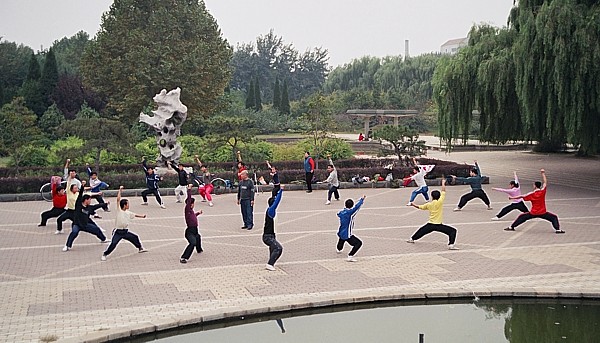
The BianhuaThe framework training (Jiazi) embodies the basic physical skills and principles essential to the understanding of meihuazhuang. In the beginning stages, the structure and composition of the Jiazi is a fixed routine. But once the practitioner has learned the basic “changing methods” (known as “bianhua”), the Jiazi is open to great freedom and variation in composition and structure. Changing methods can be created at will. But the range of possible movements must conform the Yin Yang theory. Yin and Yang alternate naturally in a state where extreme “static” will become “dynamic”, Yin changes into Yang; and extreme “dynamic” turns into “static”, Yang changes into Yin. Since the human body is seen as an inherent part of this natural change of phases, the alternations and changes of the five postures must follow the Yin Yang theory, an observance of natural laws. Thus changes between the five postures are unobstructed, fluid and continuous without any breaks in the flow of qi. The Jiazi may be practiced alone, in pairs, threes or more in a large circular formation. Training in partners and in groups enables practitioners to a “group dynamic”, develop perceptual skills, concentration, and accurate assessment of timing and distance. After this undertaking Jiazi training to acquire these basic body skills, many other open-hand forms or routines also exist. Bafang Footwork and Assorted DrillsAfter the student has learned the Jiazi, the “Bafangbu” or “Eight Direction Step” footwork pattern is taught to further develop light footwork. Bafang training consists of the Small Bafang, Middle Bafang and Large Bafang. The Small Bafang is practiced with 3 footwork positions. The Middle Bafang is practiced on 5 footwork positions and the Large Bafang had no fixed footwork positions. The goal of Meihuazhuang training it to achieve a state of holism. A condition in which the body and mind act in perfect accord. According to traditional Chinese medical theory, qi energy flows in the body as a life-giving and supporting force. The human body is a microcosmic reflection of the macrocosmic universe. In accordance with this belief, alternations and changes of the five postures are synchronized with Nature. Based on the Yin Yang theory, an observance of natural laws, changes between the five postures are unobstructed, fluid and continuous without any breaks in the flow of qi. The set must be performed continuously without breaks in thought or movement; the stake stances held totally motionless and the Moving Steps flowing smoothly. In this way, the Yin and Yang aspects are well balanced. Jiazi training aims to achieve the “Three External Coordinations” (waisanhe). These are coordinations between hand and foot, knee and elbow, shoulder and hip. Once the qi flow achieves this state, the body's movement will be fluid, soft and solid.
ChengquanView chengquan clip in RealPlayer After persisting for several months, students may also begin to study “Chengquan” — the two person training set for developing coordination, sense of direction and the ability to “listen” or “feel” to the opponent's force and act accordingly. The techniques of Chengquan train the practitioner in the use of grabbing, locking, throwing/ tripping and striking. As with the Jiazi, the training methods of Chengquan at first are fixed. Variations can be later be freely added according to the practitioner's desires and situation 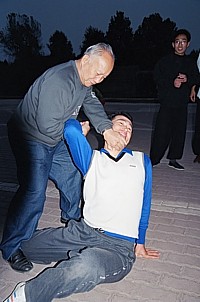
YingquanAfter several years of Jiazi and Chengquan, practitioner can begin learning Yingquan or “Winning Boxing” which is free-style sparring with the intent to develop attack and defense principles and theories. At this level, the two practitioners do not follow set handwork or set footwork but use rapid movements, interlocking footwork and skillful handwork. Qongquan — Attacking BoxingThis is a more advanced training method where a group of people may fight together. This stage possesses free-style and chaotic movements where hand techniques and footwork are used simultaneously. Those who are victorious in group fighting are considered to have achieved the Gongquan stage. 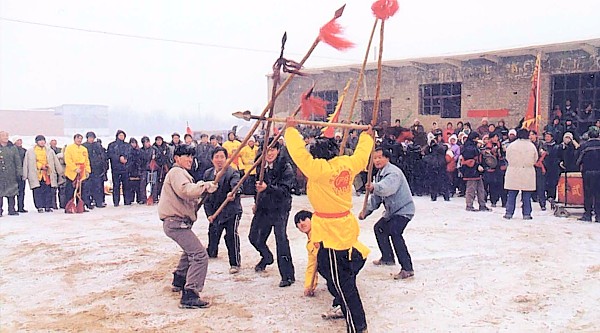
WeaponsMeihuazhuang includes the 18 types of traditional weapons as well as the practise of rarely seen weapons. These include the long spear (daqiang), luozi spear, fangbian chan, Spring and Autumn longhandled halberd, wenbang, tiji (crutch). The weapon routines are characterized by left and right side symmetrical movements, flexible changes and a powerful, grandiose character and spirit. Weapons can be performed in duel by two practitioners according to the directions of the Four Doors and the Eight Directions (Simen bafang). Their movements are unusual and are uniquely tied together with close-knit footwork. Such patterns contain practical techniques for engaging an opponent. 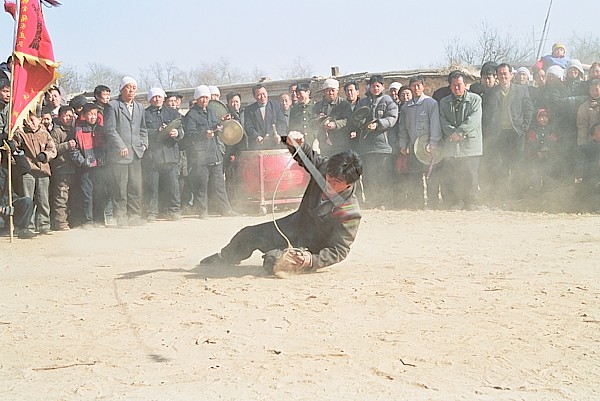
QigongQi, often translated as “internal energy”, is a foundational concept in the study of traditional Chinese culture including the arts of medicine, geomancy, numerology, martial arts, as well as philosophy and religion. This concept of qi is central to the study of traditional medicine and martial art. It is believed that qi energy circulates through the environment and is the force which supplies life to all things. Qigong refers to the practices which are concerned with the collection, nurturing and the manipulation of this qi energy within the human body to improve human health and impart special abilities. A myriad of qigong exercises and techniques exist. All have as their central aim increasing and improving the flow of qi within the body. Meihuazhuang training brings obvious benefits to the development of the external physique. However Meihuazhuang is primarily concerned with building and strengthening the body's internal qi through special qigong training methods known as wenlian (arts/civil training) training methods for developing the internal qi. Meihuazhuang's qigong training methods hold that for internal training, the formation of the “neidan” must be accomplished by training the external body or waidan. All methods emphasize the “natural collection and flow of qi”. Meihuazhuang does not employ practices which attempt to consciously force the flow of qi to some specific part of the body along a particular path. 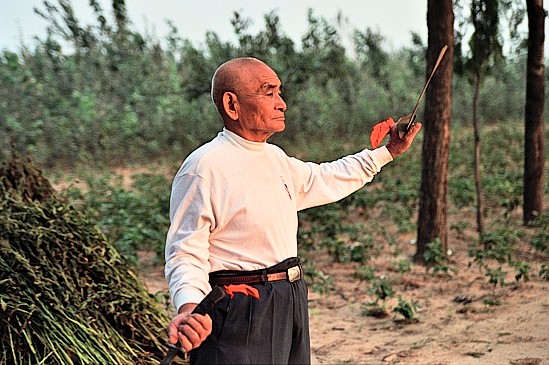
Zhuanggong — Stake GongfuAccording to previous generations of Meihuazhuang masters, in ancient times, Jiazi and Chengquan were practised on top of stakes (large wooden poles) that were driven into the ground. The height of the stakes were divided into three levels corresponding to the practitioner's skill level: low, middle and high. As each step required one stake, there were approximately 100 such wooden poles arranged over the practice field. By the late Qing dynasty, the practise of Meihuazhuang had shifted onto the ground. But the practise has maintained the original movements, steps and training methods. The style is sometimes also referred to as Luodi Wushi Meihuazhuang (Standing on the Ground Five Posture Meihuazhuang). 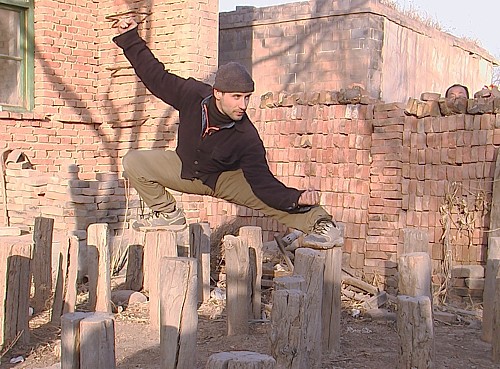
View the training outline |
